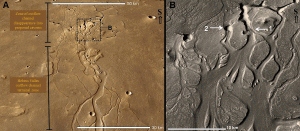Vast quantities of water have poured across the surface of Mars in ages past. The evidence is obvious in dozens of outflow channels, large and small. The waters emerged, scientists think, from subsurface reservoirs when the frozen ground capping them was broken open.

MARS FOR SPELUNKERS. At the end of its channel, the water that eroded Hebrus Valles appears to disappear underground. In image B, the flow changes from the surface to underground at the point marked 1. At point 2 is a potential collapsed roof of a cavern. (Image: NASA/JPL-Caltech/MSSS/PSI)
But where did the water end up? And what about eroded sediment carried along by the floods?
Studying Hebrus Valles and Hephaestus Fossae in the Utopia impact basin, the dozen authors of a new paper in Geophysical Research Letters write, “Our investigation indicates that outflow channel floodwaters were captured and reabsorbed into the subsurface in zones where caverns developed within the northern plains.”
Led by Alexis Rodriguez (Planetary Science Institute), the scientists used images from CTX and THEMIS coupled with topographic data from MOLA. “At some locations within the study region,” they write, “features interpreted as mud volcanoes cluster into linear ridges. These ridge patterns align with networks of individual pits, pit chains, and troughs.”
Linking the features, the team argues, are open voids in the subsurface, or caverns. “We suggest that within the study region, collapsed sections of cavern systems are expressed at the surface by these linear depressions.” The apparent connectivity of mud volcanoes with the pit and trough networks suggests a genetic link between mud volcanism and the development of cavern networks.
The scientists note that streams on Earth disappear into sinkholes, and underground conduits can carry large amounts of water and sediment.
They acknowledge that the estimated volume of the Hebrus outflow is 100 times greater than the trough networks where they end. However, they say, “we note that these trough networks likely represent only the portions of the cavern networks that collapsed.”
Caverns on Earth commonly form in carbonate rocks, such as limestone, where acidic rain and groundwater dissolves the rock starting along joints and cracks. However, if Mars has extensive carbonate rocks in the northern lowlands, geologists have yet to find them. The team, instead, proposes an alternative method of making caverns.
“Our model invokes the role of mud volcanism in the formation of subsurface caverns. High hydraulic pressures are thought to have led to mud volcanism along the southeast margins of the Utopia basin, as well as within other regions of the northern plains,” they explain.
They note that the occurrence of mud volcanoes along boundary plains fits with the idea of a pressurized hydraulic head within water-bearing rocks that extend across the highland-lowland boundary. Something – perhaps hot magma – increased the water pressure or melted the frozen ground, thus opening pathways for the water to reach the surface.
“Fluid circulation along the fractures led to the development of feeder conduits through which fluid-sediment mixtures erupted to construct mud volcanoes,” says the team. It was the enlargement of these conduits by subsurface erosion that led to the development of caverns.
How long would such caverns remain open? Potentially a very long time. The write, “At -60°C [–76°F], a predicted typical mean annual surface temperature for the investigated latitudes, permafrost could have had a mechanical strength close to that of limestone.” This could allow the formation of longterm, structurally stable caverns.
The researchers explain that “the gravity of Mars is 0.38 times that of Earth, which would have allowed for the development of 2.5 times deeper cavern systems.” Terrestrial caverns occur down to a maximum depth of about 2,000 meters (6,500 feet), thus gravity differences alone could allow Martian caverns to remain open to about 5,000 m (16,500 ft) depth – especially if deep-seated carbonates form extensive deposits within the northern lowlands’ upper crust.
Finally, the researchers note that Martian caverns could be bigger than those on Earth. “The maximum stable width of a cavern increases with the inverse square root of gravitational acceleration. Consequently, on Mars caverns within geologic materials that have similar mechanical strength could have about 60 percent wider roofs than on Earth.”
This means, they say, “If maximum cavern dimensions all scale similarly, Martian caverns could be more voluminous than Earth’s, perhaps four times greater.”









Pingback: Las cavernas subterráneas de Marte absorbieron el agua de sus inundaciones | La Universal radio